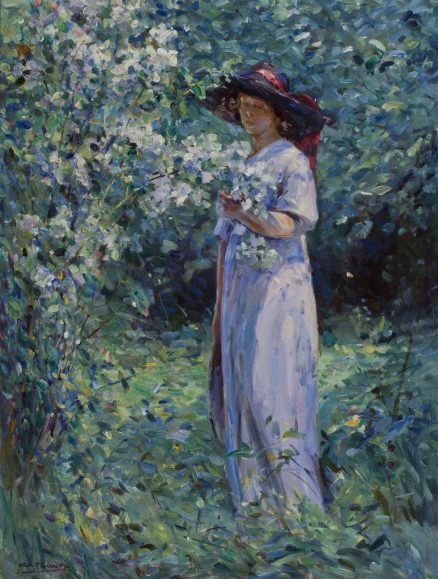- Categories
- Figural works
- Landscapes
- Women
- Zoom in on Artwork
- Print Page
- Email Page to Friend
In Romance George F. Schultz essayed a perennially popular subject in American impressionist painting: the comely young woman in a garden. Here, the standing figure seems absorbed in contemplating luxuriant blossoms whose perfect beauty parallels her own. Her white gown with its blue-violet shadows harmonizes with the flowers and lush foliage that surround her, their cool tones set off by the red scarf falling from her broad sun hat. Oblivious of being observed, the woman seems to inhabit a self-enclosed, protected world of abundance and loveliness in which the viewer is perhaps an intruder. In keeping with the habitual practice of American impressionist painters, Schultz firmly delineated the figure while rendering her surroundings more broadly in active, rapidly applied dashes of paint.
Schultz built a secure reputation as a skilled watercolor painter of landscapes and marines. Around 1910, however, he began painting woodland interiors, and then around 1913 he made several with female figures. This new direction may have been influenced by the popular paintings of, among others, Frederick Frieseke, an American expatriate artist whose lushly colored impressionist paintings of women in gardens were presented in a solo exhibition at the Art Institute in the spring of 1913. Indeed, Schultz’s Romance so closely echoes Frieseke’s Lady in a Garden (circa 1912; Terra Foundation for American Art, Chicago) as to suggest it was modeled specifically on it. Schultz showed Romance along with two similar paintings in the Art Institute of Chicago’s annual “Chicago and Vicinity” exhibition in early 1914. In this work, observed critic Harriet Monroe, the artist had achieved an “encouraging success” in “the blending of blue and green in the girl’s sunlit gown and the foliage[,] giving him a fine tonal scheme.”i
Interest in the female figure posed out-of-doors in a garden-like setting was widespread among American painters in the years just before the outbreak of World War I. As Monroe noted, the Art Institute’s 1914 exhibition included several similar images of women that were “decorative” in color as well as subject—among them Karl Buehr’s A Restful Moment. Such paintings are resolutely innocent of narrative, with the invariably young and pretty female figure given little individuality and subject matter subordinated to purely visual effects of vibrant color and brushwork. In relation to the era’s urgent concerns—the struggle for women’s suffrage, mass immigration to the U.S., labor strife, and rising militarism abroad, for example—these images envision an alternative, albeit fictitious, reality of sunny afternoons and leisurely garden strolls. The widespread appeal of this mode evidently enticed Schultz to create the only figural paintings of his career.
Wendy Greenhouse, PhD
Donated by M. Christine Schwartz to Lake Forest College, Lake Forest, Illinois, in 2021
i Harriet Monroe, “This Year’s a Young Artists’ Show,” Chicago Tribune, Feb. 8, 1914.
